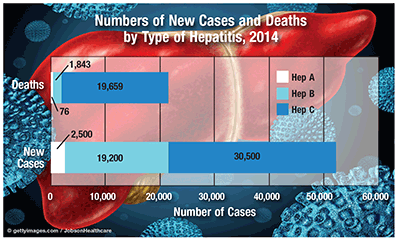US Pharm. 2017;42(4):12.
According to the CDC, the incidence of hepatitis (Hep) A undergoes an overall increase every 10 to 15 years; the last increase was in 1995, after which the incidence declined until 2011. Although the number of acute Hep B cases declined by 11.9% between 2010 and 2014, Hep B affected 2.2 million persons. The number of Hep C cases increased each year from 2010–2013 and remained stable at 0.7/100,000 population in 2013 and 2014.

Incidence: From 2000–2014, Hep A declined in all age groups except group 0–19 years (y); in 2014, group 20–29 y had the highest incidence (0.55 cases/100,000), and group 0–9 y had the lowest (0.1/100,000). In 2014, acute Hep B was highest (2.2/100,000) in group 30–39 y and lowest (0.02/100,000) in group ≤19 y. From 2010–2014, Hep C increased in groups 20–39 y and >60 y. In 2014, Hep C occurred in 51.1% of group 25–54 y and 39.1% of group >55 y. From 2010–2014, Hep C increased 3.1-fold in group 20–29 y and 2.8-fold in group 30–39 y. In 2014, group 20–29 y had the highest Hep C rate (2.2/100,000); groups 0–19 y and ≥60 y had the lowest (0.12/100,000). Hep A, B, and C declined from 2000–2010 in both sexes. In 2014, Hep A dropped to 0.4/100,000 in both males and females, and Hep C increased to 0.8 and 0.7/100,000 in males and females, respectively; overall, men exceeded women in hepatitis incidence (Hep A, 1.3-fold; Hep B, 1.8-fold. Hep C, 1.1-fold).
Risk Exposure/Behavior: Of all reported Hep A cases in 2014, 11.9% involved at least one of these risk behaviors or exposures: foodborne/waterborne outbreaks (2.6%), drug injection (4%), travel to Hep A–endemic areas (4.3%), and daycare/nursery contacts (5.9%). For Hep B, 25.8% of cases involved injection-drug use; other contributors were blood transfusion (0.07%), dialysis/kidney transplant (0.2%), occupational exposure (0.3%), accidental needlestick/puncture (4.9%), and surgery (10.8%). In 2014, of Hep C–infected persons with risky behaviors, 68.2% used injection drugs; occupational exposure (1%), dialysis/kidney transplant (0.2%), surgery (12.2%), and accidental needlestick/puncture (7.7%) were other contributors.
Death Rates: The death rate from Hep A was significantly lower in 2014 (0.02/100,000) than in 2010, but it was higher in persons aged ≥55 y (0.07/100,000). The Hep C–related mortality rate in males was 2.6 times greater than that in females. Of the three types of hepatitis, Hep C accounted for the greatest number of deaths, as well as the highest mortality rate (5 deaths/100,000) in 2014. Persons aged 55–64 y accounted for 50.9% of Hep C–related deaths in 2014.
To comment on this article, contact rdavidson@uspharmacist.com.





